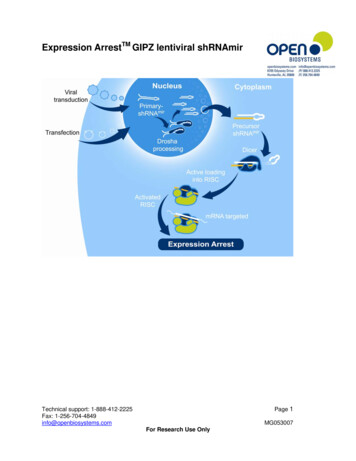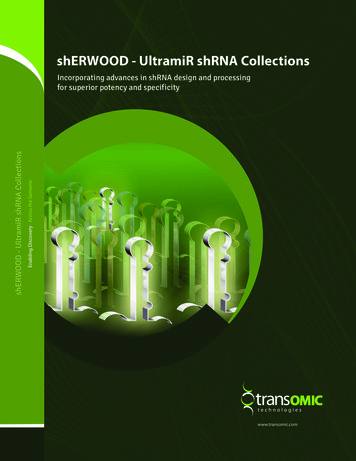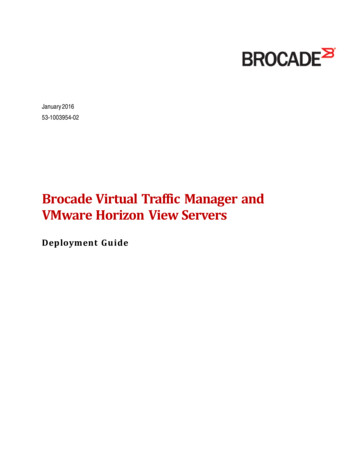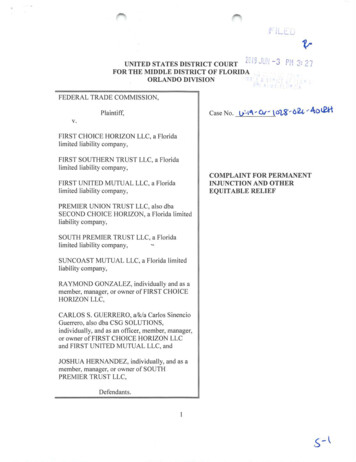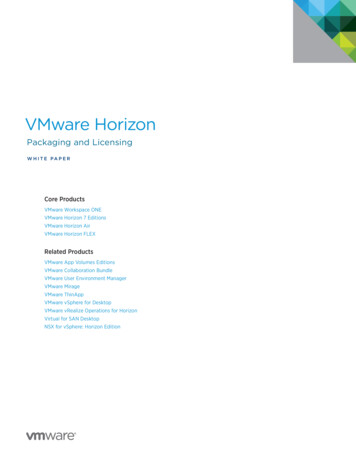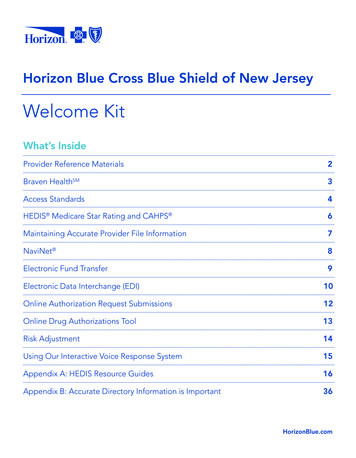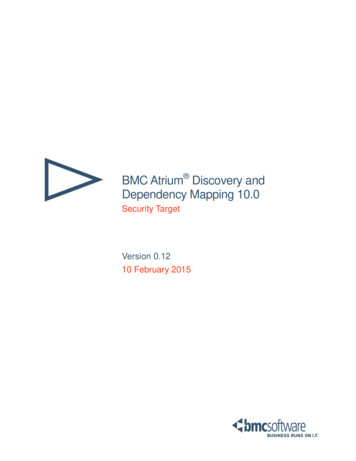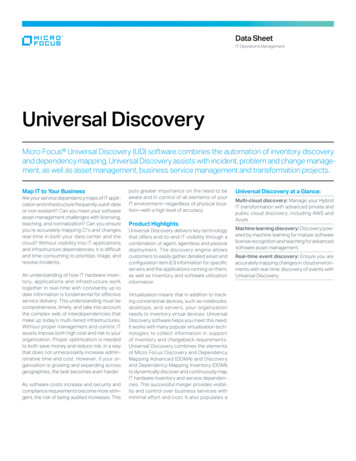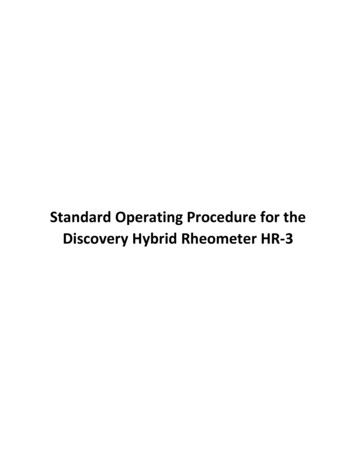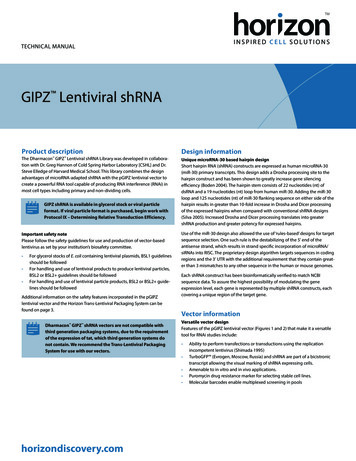
Transcription
TECHNICAL MANUALGIPZ Lentiviral shRNAProduct descriptionDesign informationThe Dharmacon GIPZ Lentiviral shRNA Library was developed in collaboration with Dr. Greg Hannon of Cold Spring Harbor Laboratory [CSHL] and Dr.Steve Elledge of Harvard Medical School. This library combines the designadvantages of microRNA-adapted shRNA with the pGIPZ lentiviral vector tocreate a powerful RNA tool capable of producing RNA interference (RNAi) inmost cell types including primary and non-dividing cells.Unique microRNA-30 based hairpin designShort hairpin RNA (shRNA) constructs are expressed as human microRNA-30(miR-30) primary transcripts. This design adds a Drosha processing site to thehairpin construct and has been shown to greatly increase gene silencingefficiency (Boden 2004). The hairpin stem consists of 22 nucleotides (nt) ofdsRNA and a 19 nucleotides (nt) loop from human miR-30. Adding the miR-30loop and 125 nucleotides (nt) of miR-30 flanking sequence on either side of thehairpin results in greater than 10-fold increase in Drosha and Dicer processingof the expressed hairpins when compared with conventional shRNA designs(Silva 2005). Increased Drosha and Dicer processing translates into greatershRNA production and greater potency for expressed hairpins.GIPZ shRNA is available in glycerol stock or viral particleformat. If viral particle format is purchased, begin work withProtocol IX – Determining Relative Transduction Efficiency.Important safety notePlease follow the safety guidelines for use and production of vector-basedlentivirus as set by your institution’s biosafety committee. For glycerol stocks of E. coli containing lentiviral plasmids, BSL1 guidelinesshould be followedFor handling and use of lentiviral products to produce lentiviral particles,BSL2 or BSL2 guidelines should be followedFor handling and use of lentiviral particle products, BSL2 or BSL2 guidelines should be followedAdditional information on the safety features incorporated in the pGIPZlentiviral vector and the Horizon Trans-Lentiviral Packaging System can befound on page 3.Dharmacon GIPZ shRNA vectors are not compatible withthird generation packaging systems, due to the requirementof the expression of tat, which third generation systems donot contain. We recommend the Trans-Lentiviral PackagingSystem for use with our vectors.Use of the miR-30 design also allowed the use of ‘rules-based’ designs for targetsequence selection. One such rule is the destabilizing of the 5' end of theantisense strand, which results in strand specific incorporation of microRNA/siRNAs into RISC. The proprietary design algorithm targets sequences in codingregions and the 3' UTR with the additional requirement that they contain greater than 3 mismatches to any other sequence in the human or mouse genomes.Each shRNA construct has been bioinformatically verified to match NCBIsequence data. To assure the highest possibility of modulating the geneexpression level, each gene is represented by multiple shRNA constructs, eachcovering a unique region of the target gene.Vector informationVersatile vector designFeatures of the pGIPZ lentiviral vector (Figures 1 and 2) that make it a versatiletool for RNAi studies include: horizondiscovery.comAbility to perform transfections or transductions using the replicationincompetent lentivirus (Shimada 1995)TurboGFP (Evrogen, Moscow, Russia) and shRNA are part of a bicistronictranscript allowing the visual marking of shRNA expressing cells.Amenable to in vitro and in vivo applications.Puromycin drug resistance marker for selecting stable cell lines.Molecular barcodes enable multiplexed screening in pools
From PowerPoint (R&D)Revised versionsAntibiotic resistancehCMVtGFPRREpGIPZ contains three antibiotic resistance markers (Table 2).WPuroRIREStGFPRREWPREPuroRIREShCMVΨ3' SIN LTR5' LTRpGIPZAmpRSV40 oripUC oriAntibioticConcentrationAmpicillin (carbenicillin) 100 μg/mLZeocin 5ʹ LTRΨTable 2. Antibiotic resistances conveyed by pGIPZ.shRNA25 μg/mLPuromycinVariableshRNAUtilityBacterial selection markerpGIPZ(outside LTRs)Bacterial selection marker(inside LTRs)RpUCoriAmpMammalianselection marker SV40 oriFigure 1. pGIPZ lentiviral vector.Quality controlThe GIPZ Lentiviral shRNA Library has TREpassed through internal QC processesUBCtoensure high quality and low recombination (Figures 3 and 4).RRErtTA3 IRES PurotRFPshRNAΨUBCTREVector elementUtilityPuroR WPREIRESrtTA3tRFPRREhCMVHuman cytomegalovirus promoter drives strong transgeneexpressionshRNAtGFPTurboGFP reporter for visual tracking of transduction andexpressionΨTable 1. Features of the pGIPZ vector.5' LTR3' SIN LTRΨRRERRE3' SIN LTR3' self-inactivatinglong terminal repeat for increasedhCMVlentivirus safetyRWPREtGFPIRESallowsPuroshRNApackagingPsi packagingsequenceviral genomeusing lentiviral packaging systemsRev response element enhances titer by increasingpackaging efficiency of full-length viral genomesWoodchuck hepatitis posttranscriptional regulatoryelement enhances transgene expression in the target cellspSMART 2.05' LTRWPREVector mapAmpRIRES5ʹ LTRtGFPcPPT/CTSPuroRshRNAWpSMART 2.0pUCoriSV40 orihPGKU6PuroRshRNAFigure 4. Gel image of a restriction digest of clones from the GIPZ shRNA libraryshRNAcultured for 10 successive RREgenerations in an attemptto determine the tendency of thepGIPZ vector to recombine. Each generation was thawed, replicated and incubatedovernight for 16 hours at 30 C then frozen, thawed and replicated. This process wasrepeated for 10 growth cycles. After the 10th growth cycle, plasmid was isolated andnormalized to a standard concentration. Clones were digestedpLKO.1with SacII and run onan agarose gel. The pGIPZ vector appears stable without showing any recombination.Expected band sizes: 1259 bp, 2502 bp, and 7927 bp. 10 kb molecular weight ladder(10 kb, 7 kb, 5 kb, 4 kb, 3 kb, 2.5 kb, 2 kb, 1.5 kb, 1 kb).PuroR3' SIN LTRRSV/5' LTRpLKO.1pGIPZ11.8 kbAmpRpUC oriRSV/5ʹ LTRΨΨRRERREAmpRhPGKU6SV40 oriFigure 3. Representative GIPZ Lentiviral shRNA clones grown for 16 hours at 30 C.Plasmid was isolated and normalized to a standard concentration. Clones were thendigested with SacII and run on an agarose gel with uncut plasmid. The expected bandsizes are 1259 bp, 2502 bp, and 7927 bp. No recombinant products are visible. 10 kbhCMVmolecular weight ladder (10 kb, 7 kb, 5 kb, 4 kb, 3 kb, 2.5 kb, 2 kb, 1.5 kb, 1 kb).SV40 oripUC oripUCoriAmpRΨshRNApTRIPZ5ʹ LTR5' LTRIRESΨ3' SIN LTRpTRIPZPuromycin resistance permits antibiotic-selective pressureand propagation of stable integrantsInternal ribosomal entry site allows expression of TurboGFPRSV40oripUCAmpand puromycinresistancegenesin aorisingle transcriptmicroRNA-adapted shRNA (based on miR-30) forgene knockdown5' long terminal repeatPuroRAmpRpUCoriAdditional safety informationhCMVtGFPIRESPuroRmicroRNAWPRE3' SIN LTR5' LTRpSMART 2.0R GeneiousDrawing was createdusing(http://www.geneious.com).SV40 orioripUCAmpFigure 2. Detailed vector map of pGIPZ lentiviral vector.horizondiscovery.com-2atGFPIRESORF5ʹ LTRΨΨRREHistorically, the greatest safety risk associated with ahCMVlentiviral deliveryplatform stems from theRREpotential generation of recombinantvirusesPurothat R microRNAtGFP IRESare capable of autonomous replication. The pGIPZ Lentiviral shRNA platformminimizes these hazards to the greatest degree by combining a disabled viralgenome with the proprietary Trans-Lentiviral packaging process. Starting with2.0the HXB2 clone of HIV-1 (GenBank,Accession#K03455), the lentiviral backbonepSMARThas been modified to eliminate all but the most essential genetic elementsnecessary for packaging and integration (such as 5' LTR, Psi sequences, polypurine tracts, Rev responsive elements and 3' LTR). The resultant self-inactivatingRSV40 oripUCoriAmp(SIN) vector greatly reduces the probabilityof producingrecombinant particlesand limits cellular toxicity often associated with expression of HIV genes.hCMVhCMVnucBlast RWPRERREORFIREStGFPnuc -2a- BlastR
Additional safety features can be incorporated by the packaging processitself. Generation of pGIPZ Lentiviral shRNA particles requires a packagingstep during which the expression construct containing the silencing sequenceis enclosed in a viral capsid. Gene functions that facilitate this process (suchas those encoded by the structural genes gag, pol, env, etc.) are distributedamongst multiple helper plasmids which do not contain significant regionsof homology. This tactic further minimizes the probability of recombinationevents that might otherwise generate viruses capable of autonomousreplication. Among commercially available lentiviral vector systems, theTrans-Lentiviral Packaging System offers a superior safety profile as thepackaging components are separated onto five plasmids. Additionally,expression of gag-pro and tat-rev are under the control of the conditionaltetracycline-responsive promoter element (TRE), limiting expression ofthese viral components strictly to the packaging cell line. A detailed descriptionof the Trans-Lentiviral Packaging System can be found in (Wu 2000).Table 3. Materials for plate replication.With these safety measures in place, GIPZ lentiviral shRNA particles can beemployed in standard Biosafety Level 2 tissue culture facilities.Replication of platesPrepare target plates by dispensing 160 μL of 2x LB broth (low salt) mediumsupplemented with 8% glycerol** and appropriate antibiotic (25 μg/mL Zeocinand 100 μg/mL carbenicillin).Prepare source platesRemove foil seals from the source plates while they are still frozen. Thisminimizes cross-contamination. Thaw the source plates with the lid on. Wipe anycondensation underneath the lid with a paper wipe soaked in ethanol.Any investigator who purchases Horizon viral vector products is responsiblefor consulting with their institution’s health and biosafety group for specificguidelines on the handling of lentiviral vector particles. Further, eachinvestigator is fully responsible for obtaining the required permissions for theacceptance of lentiviral particles into their local geography and institution. In the U.S., download the U.S. Department of Health and Human ServicesCenters for Disease Control and Prevention and National Institutes ofHealth, Biosafety in Microbiological and Biomedical Laboratories (BMBL),Fifth Edition, Feb 2007 here. See also: NIH Guidelines For Research Involving Recombinant DNAMolecules (NIH Guidelines), September 2009, downloadable here. For Biosafety Considerations for Research with Lentiviral Vectors, see.Replication of individual clonesOnce the clone has been streak isolated and the identity of the strain has beenconfirmed** by Sanger sequencing (See: What is the sequencing primer forpGIPZ?), we recommend making a stock of the pure culture. Grow the pureculture in LB broth appropriate antibiotic (See protocol below: Protocol1 - replication). Vortex the culture to evenly mix the glycerol throughout theculture. The culture can be stored indefinitely at –80 C.**Testing of 3-5 colonies is recommended.Protocol I – replicationFor archive replication, grow GIPZ shRNA clones at 30 C in 2x LB broth(low salt)* medium plus 25 μg/mL Zeocin and 100 μg/mL carbenicillin in orderto provide maximum stability of the clones. Prepare medium with 8% glycerol**and the appropriate antibiotics.2x LB broth (low-salt) medium preparationLB-Broth-Lennox20 g/LPeptone10 g/LYeast Extract5 g/LAppropriate antibiotic(s) at recommended concentration(s). Glycerol 8% forlong-term storage.*1x LB medium can be used instead of 2x LB broth medium.**Glycerol can be omitted from the medium if you are culturing for plasmidpreparation. If making copies of the constructs for long-term storage at–80 C, 8% glycerol is requiredItemVendorCat #2x LB Broth (low salt)Fisher ScientificBP1427500Peptone, granulated, 2 kg – DifcoFisher ScientificBP9725-2Yeast Extract, 500 g, granulatedFisher ScientificBP1422-500NaClFisher ScientificBP3581GlycerolFisher ScientificBP2291CarbenicillinFisher ycinFisher ScientificBP2956-10096-well microplatesFisher Scientific12-565-363Aluminum sealsFisher Scientific12-565-475Disposable replicatorsFisher ScientificNC9584102Replicate1. Gently place a disposable replicator in the thawed source plate and lightlymove the replicator around inside the well to mix the culture. Make sure toscrape the bottom of the plate of the well.2. Gently remove the replicator from the source plate and gently place in thetarget plate and mix in the same manner to transfer cells.3. Dispose of the replicator.4. Place the lids back on the source plates and target plates.5. Repeat steps 1-4 until all plates have been replicated.6. Return the source plates to the -80 C freezer.7. Place the inoculated target plates in a 30 C incubator for 18-19 hours.Freeze at -80 C for long-term storage. Avoid long periods of storage at roomtemperature or higher in order to control background recombination products.Due to the tendency of viral vectors to recombine, werecommend keeping the incubation times as short aspossible and avoid subculturing. Return to your glycerolstock of your pure culture (see Replication of individualclones) for each plasmid preparation.Protocol II – Plasmid preparationCulture conditions for individual plasmid preparationsFor plasmid preparation, grow all GIPZ shRNA clones at 37 C in 2x LB broth(low salt) medium plus 100 μg/mL carbenicillin only.1. Upon receiving your glycerol stock(s) containing the shRNA of interest,confirm the clone identity (See: Replication of individual clones) and storeimmediately at –80 C until ready to begin.2. To prepare plasmid DNA, first thaw your glycerol stock culture and pulsevortex to resuspend any E. coli that may have settled to the bottom ofthe tube.3. Take a 10 μL inoculum from the glycerol stock into 3–5 mL of 2x LB broth(low salt) medium with 100 μg/mL carbenicillin. Return the glycerol stock(s)to –80 C.If a large culture volume is desired, incubate the 3-5 mL culturefor 8 hours at 37 C with shaking and use as a starter inoculum.Dilute the starter culture 1:500–1:1000 into the larger volume.4. Incubate at 37 C for 18–19 hours with vigorous shaking.horizondiscovery.com
5. Pellet the culture and begin preparation of plasmid DNA. Plasmid DNAcan be isolated using Thermo Scientific GeneJET Plasmid Miniprep Kit(Cat #K0502) or similar.6. Run 0.2–1 μg of the plasmid DNA on a 1% agarose gel. pGIPZ with shRNAis 11774 bp.Due to the tendency of viral vectors to recombine, werecommend keeping the incubation times as short aspossible and avoid subculturing. Return to your originalglycerol stock of your pure culture (see Replication ofindividual clones) for each plasmid preparation.Culture conditions for 96-well bio-block plasmid preparationInoculate a 96-well bio-block containing 1 mL per well of 2x LB broth (lowsalt) medium with 100 μg/mL carbenicillin with 1 µL of the glycerol stockculture. Incubate at 37 C with shaking ( 170–200 rpm). We have observedthat incubation times between 18–19 hours produce good plasmid yield.For plasmid preparation, follow the protocols recommended by the plasmidisolation kit manufacturer.For the library collection, we use the above 96-well bioblock plasmid preparation protocol in conjunction witha Qiagen Turbo Kit (Cat #27191). We use 2 bio-blockscombined. Do not perform the optional wash and elute theDNA in molecular grade water.Protocol III – restriction digestThe following is a sample protocol for restriction enzyme digestion usingThermo Scientific FastDigest Restriction Enzymes KpnI (Cat #FD0524), SalI (Cat#FD0644), XhoI (Cat #FD0694) and/or NotI (Cat #FD0594) and Thermo Scientific Restriction Enzyme SalI (Cat #ER0205) for diagnostic quality control of pGIPZlentiviral vectors.1. Add the following components (Table 4), in the order stated, to a sterilePCR thin-wall tube.2. Mix gently by pipetting.3. Incubate in a thermal cycler at 37 C for 5 minutes for FastDigest enzymesor as suggested by the manufacturer.4. Load the gel with 10 µL of each of the digested samples, KpnI, SacII, SalI,XhoI and/or NotI on a 1% agarose gel. Run uncut sample alongside thedigested samples. (Figure 5).Table 4. Restriction digest components.ComponentAmountWater, nuclease-free (Cat #R0581)X μL10x FastDigest buffer2 μLDNA sample (up to 1 µg) in waterX μLFastDigest enzyme1 μLFinal Volume20 μLProtocol IV – TransfectionQuantities and volumes should be scaled-up according to the number ofcells/wells to be transfected (Table 5). This example is for 24-well plate format.1. In each well, seed 5 104 adherent cells or 5 105 suspension cells in0.5 mL of growth medium 24 hours prior to transfection.The recommended confluency for adherent cells on theday of transfection is 70-90%. Suspension cells should bein logarithmic growth phase at the time of transfection.horizondiscovery.com1Lane 1 Lane 2 Lane 3 Lane 4 Lane 5 Lane 6 -2345610 kb molecular weight ladder (10 kb, 7 kb, 5 kb, 4 kb, 3 kb, 2.5 kb,2 kb, 1.5 kb, 1 kb)Uncut pGIPZ vectorKpnI digested pGIPZ produces two bands at 1917 bp and 9857 bp.SacII digest produces three bands at 1345 bp, 2502 bp and 7927 bpSalI produces three bands at 2188 bp, 4465 bp and 5121 bpXhoI, NotI double digest produces two bands at 1291 bp & 10,483 bp2. Dilute 1 µg of DNA in 50 µL of DMEM or other serum-free growth medium.3. Gently mix DharmaFECT kb transfection reagent and add 3 µL to the dilutedDNA. Mix immediately by pipetting.4. Incubate 10 minutes at room temperature. Remove medium fromwells and replace with 0.45 mL fresh growth medium.Prepare immediately prior to transfection. We recommendstarting with 1 µg of DNA and 3 µL of DharmaFECT kbreagent per well in a 24-well plate (see scale-up Table 5).Subsequent optimization may further increase transfectionefficiency depending on the cell line and transgene used.5. Gently add 50 µL of the DharmaFECT kb reagent/DNA mixture to each well.The transfection efficiency with DharmaFECT kbtransfection reagent (Horizon, Cat #T-2006-01) is equallyhigh in the presence of serum. This is not the case withother transfection reagents.6. Gently rock the plate to achieve even distribution of the complexes.7. Incubate at 37 C in a CO2 incubator.8. Analyze transgene expression 24-48 hours later. For stable transfection,cells should be grown in selective medium for 10-15 days (see Protocol V –Puromycin Selection).
Table 3. Scale-up ratios for transfection of adherent and suspensioncells with DharmaFECT kb transfection reagentTissue culture vesselGrowth area,cm2/wellVolume ofmedium, mLAdherent (suspension) cells to seedthe day before transfection*96-well plate0.30.148-well plate0.724-well plate12-well plateAmount of DNAVolume of DharmaFECT kb, μLµg**µL***0.5-1.2 104 (2.0 104)0.20.251.0-3.0 10 (5.0 10 )0.52.00.52.0-6.0 10 (1.0 10 )1.04.01.00.4-1.2 105 (2.0 105)2.06-well plate9.52.00.8-2.4 10 (4.0 10 )4.02009.06.0-12.060 mm plate203.02.0-6.3 105 (1.0 0.4-1.0251.50.8-2.2503.02.0-5.01006.03.9-9.0* These numbers were determined using HEK293T and U2OS cells. Actual values depend on the cell type.** Amount of DNA and DharmaFECT kb transfection reagent used may require optimization.*** The volume of DNA should be 1/10 of the volume of the culture medium used for dilution of the DNA.Protocol V – Puromycin selectionDetermining antibiotic dose response (Kill curve)In order to generate stable cell lines expressing the transgene of interest, itis important to determine the minimum amount of antibiotic required to killnon-transfected cells. A simple procedure to test this is as follows:1. Day 1: Using the same cell type and relative cell densities to be used insubsequent transfection or transduction procedures, plate cellsand culture overnight.2. Day 2: Replace complete growth medium with growth mediumsupplemented with a range of puromycin concentrations (0-15 μg/mL),including untreated control cells with no antibiotic added.
Vector map Figure 2. Detailed vector map of pGIPZ lentiviral vector. Antibiotic resistance pGIPZ contains three antibiotic resistance markers (Table 2). IRES Puro R Amp R pUC ori SV40 or i tGFP hCMV RRE shRNA WPRE 5' LT R 3' SIN LT R Ψ pGIPZ pTRIPZ tRFP rt TA3 TRE UBC Revised versions From PowerPoint (R&D) pLOC pLKO.1 U6 hPGK pSMART 2.0 SV40 .
